Are you interested in starting your own ecommerce dropshipping business but don’t want to deal with the hassle of managing inventory and shipping products?
Then dropshipping business may be the perfect solution for you! In fact, dropshipping is becoming an increasingly popular business model, with an estimated 22-33% of online retailers using this method.
And with the global dropshipping business market projected to reach $476.1 billion by 2026 acccording to Statista, there’s never been a better time to jump on the bandwagon.
This shows that more and more entrepreneurs are recognizing the benefits of dropshipping, such as low startup costs and the ability to sell a wide variety of products without ever having to touch them.
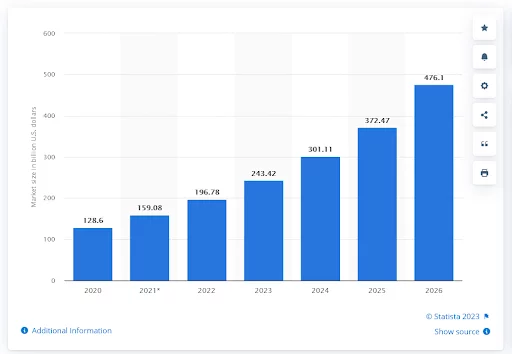
What is Dropshipping?
Hey there, fellow entrepreneur-in-the-making! Are you ready to jump headfirst into the world of ecommerce but don’t want to deal with the headache of inventory and shipping?
Well, let us introduce you to the magical world of dropshipping – where the sky’s the limit and the world is your oyster.
Dropshipping is a genius business model where you partner with a supplier who handles all of the pesky logistics, such as warehousing and shipping.
That means you get to focus on building your brand and customer base without having to worry about the boring stuff.
But that’s not all – dropshipping also allows for low startup costs and flexible working hours, making it the perfect option for go-getters who want to build a successful business without breaking the bank.
And the best part? You can sell practically anything under the sun, from funky jewelry to cozy blankets to hilarious t-shirts with your face on them (we won’t judge).
The world is your oyster, my friend! So, if you’re ready to take the leap and start your own online empire, dropshipping business is the way to go. With a little bit of creativity and a whole lot of hustle, you can build a thriving business in no time. So what are you waiting for? Let’s make some magic happen!
Key Players In Dropshipping Model
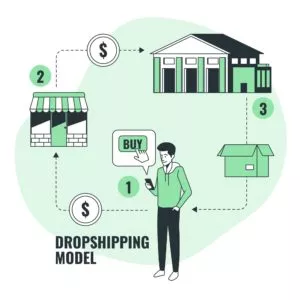
1. Seller of Record
The first step in dropshipping is deciding to do so. One way to put it is that you are the seller of record (SoR) if you are the person who is officially listed as selling the product to the consumer. You are responsible to collect and remit the appropriate sales tax on each sale you make.
You are the seller of record because you own the things before they ship to the consumer, even if third party stocks and sends the items. As long as you’re the seller of record and clearly label yourself as such, Amazon’s dropshipping policy allows you to use a dropshipping service.
2. Manufacturers
Wholesalers and retailers buy from manufacturers, who then create the goods they sell. Manufacturers are a valuable source for items, but the minimum order quantities they may ask might make it difficult to launch or expand a firm. Dropshipping is a service that some factories provide.
3. Wholesalers
As part of the distribution process, wholesalers acquire goods directly from manufacturers before selling them to retailers at a modest markup.
Companies like these act as intermediaries; rather than selling directly to customers, they connect merchants with suppliers via drop shipping. Your business’s fulfillment needs and model will inform your decision on which dropshipping companies to pursue.
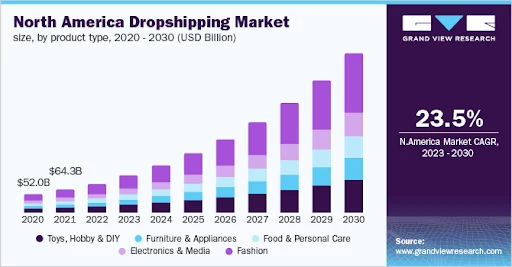
Benefits of Dropshipping Business
1. It takes less money to start a dropshipping business
Although a dropshipping business doesn’t require a large initial investment for inventory, it’s easy to start sourcing items and launching a profitable business with little capital. Get your online shop up and running without spending tens of thousands on the stock.
No need to spend money on a product until after you’ve successfully closed a transaction and received payment from the client. Compared to a conventional retail store, the startup costs for a dropshipping business are lower.
2. It reduces the barriers to entry
Avoiding the hassle of shipping and handling real goods may greatly simplify the management of an online store.
Dropshipping relieves you of the following responsibilities: running and staffing a warehouse; packing and shipping orders; keeping tabs on stock for bookkeeping purposes; dealing with returns and incoming shipments; continuously purchasing items and monitoring stock level; and so on.
As a result of the reduced costs associated with drop shipping,
3. No need to worry about stocking shelves or running a storage facility
This results in significantly reduced general operating costs. Some thriving online dropshipping shops are operated out of the owner’s house with little more than a laptop computer and some regular overhead.
These expenses will rise as you expand, but they will be minimal compared to those of a storefront establishment.
4. Drop shipment allows you geographical flexibility
You may manage your dropshipping company from any location with access to the Internet. Any firm can function and be managed with open communication lines with suppliers and customers. Because of this, dropshipping is a practical option for many firms.
5. Diverse inventory to choose from
As there is no need to stock up in advance, you may provide clients with a wide selection of the latest and greatest products. It is unnecessary to pay more to have an item listed for sale on your website if your suppliers have it in stock.
6. Less cumbersome to go through the exam
It’s a good idea to utilize dropshipping as a fulfillment method when starting or to see how your consumers react to trying something new, like an accessory or an entirely different product line.
7. Simplified expansion
Normal retail operations require three times as much labor when hit with a threefold increase in order volume. You may develop your business with fewer growing pains and less incremental effort by utilizing dropshipping providers since most suppliers will shoulder the burden of processing more orders.
Dropshipping business scales better than standard ecommerce firms, even though more sales always necessitate more effort, particularly in customer care. The primary advantage once again lies in the opportunity to test the market for a product and sell it before investing much in stock.
Estimated Costs Of Setting Up A Dropshipping Business Model
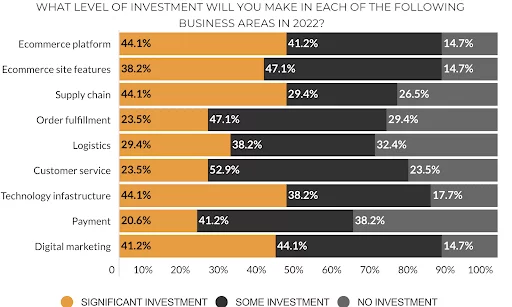
Online store
Estimated cost: ~$39/month
Finding an ecommerce platform or website builder is essential to establishing and maintaining your virtual storefront. When opening a store, Shopify is our clear recommendation.
You’ll have seamless integration with the Oberlo marketplace to find items and access our available themes and free branding tools to launch your company immediately. Nestify is another hosting platform that offers seamless functioning of the store.
Domain name
Estimated cost: $5-20/year
With your domain name, it’s easier to gain client confidence. We suggest searching for a .com that suits your brand if one is available, while there are several TLDs to choose from (such as .io or .co.in). You may get going quickly by using our domain name generator, or you can read up on creating a memorable brand name.
Test orders
Estimated cost: Varies
While dropshipping frees you from managing the full inventory, you still need to set aside some funds and time to evaluate the quality of the items you want to sell. If you do, you can only offer a product with a few problems for buyers to overlook, leading to negative feedback and hassle with returns.
Online advertising
Estimated cost: Scales with your business; we recommend budgeting at least $500 monthly.
Every online retailer has to focus on lowering the cost per acquisition by maximizing the effectiveness of free marketing strategies, including content promotion, search engine optimization, and word of mouth.
Nonetheless, for most product-based firms, advertising is a crucial initial channel. The most popular methods are advertising through search engines, social media, display networks, and mobile devices.
The 5 Hallmarks of a Successful Dropshipping Business
1. Unique selling point (USP)
Use creative thinking to find your niche. To be competitive, you must always ask: what does my shop provide that others don’t?
This sums up the core concept behind a USP, or distinctive selling proposition. Do you plan on peddling apparel aimed squarely toward female consumers? Shoes for running, perhaps? That’s OK; so do thousands of other dropshippers. How will customers be able to set your dropshipping business apart from the competition? You’re competing with many other retailers, so what makes people want to buy from you instead of them?
Several shops have a serious identity crisis because of this. In all honesty, this is unacceptable since consumers are becoming weary of generic retail environments and yearning for a breath of fresh air.
Here’s how you can develop your own USP:
- Custom fonts (Blue CrateNotebook Therapy)
- Photography (Aesthentials /Mooshe Socks)
- Unique products (Oddity Mall /Wallplate Warehouse)
2. Clear and simple store
Nowadays, people can hardly focus for a minute. As important as it is for businesses to be visually appealing, the layout must be straightforward so that customers can easily move from point A to point B to point C, which is the shopping cart.
Using many colors is fantastic, but ensure enough white space to avoid overwhelming the viewer. The general guideline for providing visuals and fewer words is good. Design your store layout so customers can easily find what they want. The most common paths taken by successful dropshipping stores are:
It would help if you never deviated from the straight path that converts visitors into buyers, such as including an “often bought together” or “from the same collection” section to increase sales. There isn’t a better place to go than either Bidet Genius or Wallplate Warehouse.
Also Read: Choose Dropshipping with WooCommerce in 2023 for Swift E-Store Business
3. Great SEO score
The best dropshipping stores have great search engine optimization rankings. Everyone would like their shop to come up #1 in Google search results for the terms their target audience uses to find them.
We know SEO is a large issue so that we won’t delve into the details here, but we have included some easy strategies to get started with SEO for your online store:
- Use an SEO plugin app. Shopify’s store offers various SEO plugins that analyze your site and provide optimization recommendations.
- Create unique material; search engines prioritize this. Unique content increases your site’s chances of being seen in Google’s search results.
- It would be best to incorporate keywords that people use to find things like yours, as long as it doesn’t sound forced. They can be incorporated into web address (URL) structures, meta descriptions, item descriptions, and picture alt tags.
- Creating a blog is an excellent platform for written product promotion.
Getting your blogs to the top of search engine results for a specific topic will bring in more visitors and increase sales.
4. Free shipping
Primary reason for digital shoppers in the United States to abandon their carts as of December 2022 can be shown below:
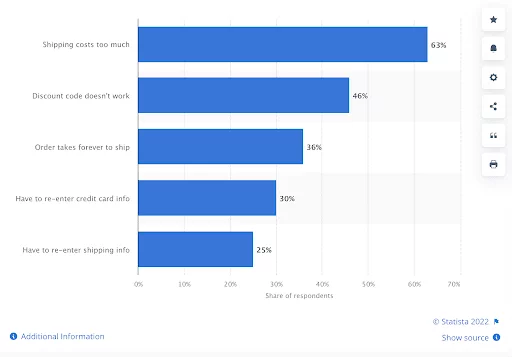
You’re already behind the eight ball without free delivery as an option on your dropshipping website. As more people shop online, free and cheap shipping is perceived less as a generous indulgence and more as usual. For instance, sending a waffle iron from Vermont to California doesn’t have to break the bank. Some tricks that can be up your sleeve can be:
- Deduct the delivery cost from your revenues and offer free shipping on everything.
- incentivize large purchases by providing free shipping on orders exceeding some threshold.
- Provide inexpensive shipping and make up the difference by marking up the price of your goods in some other way.
Read Also: Why Calculating Shipping Cost in Advance is the Best Way to Save Money?
5. Great social media following
The ecommerce sector is seeing massive growth thanks to social media:
Over 90% of Instagram users follow a business, while 89% of marketers utilize Facebook for online marketing. There needs to be a justification for a retail business in this day and age not to have a social media presence. These channels not only aid in expanding your consumer base and brand awareness, but they also allow you to connect with, or build, communities that may serve as a wealth of insight into your strengths, weaknesses, and future directions as a business.
Naturally, not all products are suited for social media (Bidet Genius and Wallplate Warehouse anyone? ), but getting your leads on social media could mean enormous income for your store.
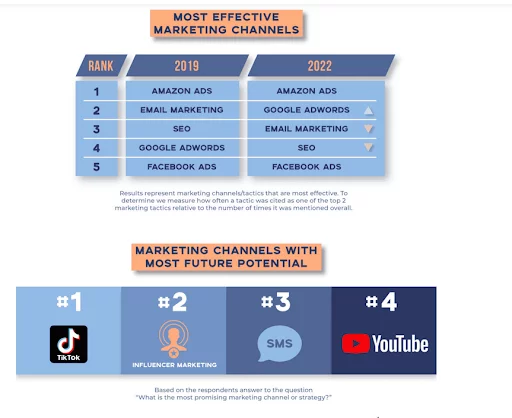
Steps For Setting Up A Dropshipping Business
Step 1: Find dropshipping products that are in demand
If you’re starting in ecommerce, finding the perfect things to offer on your website might take a lot of time. To succeed as a dropshipping ecommerce firm, you must stock your online shop with items people want.
Choosing the correct items in a dropshipping business requires extensive study into what is currently popular. Focusing on a specific niche is best if you want to make money with your dropshipping company.
Google Trends is only one of several tools you can use to find the most in-demand items to stock your dropshipping business with. Another option is finding out what products are doing well and what’s new on supplier websites.
Using competitive channels like eBay, Shopify, the Facebook Marketplace, etc., you may learn what goods are most successful for other sellers by conducting competitive research. Check out 2023’s top platforms for your store in the blog.
You may also look for product hashtags on social networks like TikTok to learn more about a product’s reception among the general public.
Step 2: Choose a supplier that is right for you
Every successful dropshipping business needs a reliable dropshipping provider. You can only expect your dropshipping business to thrive with the correct balance of suppliers. Because of this, you must understand how to locate reliable dropshipping providers that can facilitate the smooth operation of your business.
In your hunt for the optimal distribution of suppliers, you may come across two types of companies: dropshipping vendors and dropshipping wholesalers.
It’s common for dropshipping sellers to deliver merchandise in a certain niche or product range and charge more per unit than wholesalers do since they buy in bulk. If you team up with them, you can provide your clients with a great deal.
Before deciding to engage with a certain supplier, you should study them, learn about the technologies they use, and, in general, talk to them and familiarize yourself with their business practices. Be wary of vendors who want regular payments before agreeing to work with them.
Pre-order fees are common for suppliers to charge, with the cost often increasing for more complicated purchases. Nevertheless, it would help if you were wary of vendors who charge far more than the industry standard.
Step 3: Select a channel to sell your products
You’ve done your homework and found a great product and supplier for your dropshipping business; now it’s time to choose where to sell those items.
Several different types of sales channels may not be suitable for your business. For instance, if your product is very specialized and only appeals to a certain population, you should market it on a platform the group heavily uses.
It is crucial to have a firm grasp of your product, its target market, and the appropriate selling channels to reach that market. eBay, Shopify, Facebook Marketplace, and Wix are just a few of the most well-known ecommerce platforms.
Learn more about dropshipping platforms and its features in this blog.
Step 4: Create your dropshipping website
A dropshipping website is an online storefront where you send orders directly to customers. Your platform is where you interact with suppliers, where clients discover your items, and where platform’s technology handles all of your business activities.
eBay is one such site, as sellers can open a storefront for free and tailor it to their needs. While eBay allows you to personalize your storefront, Facebook Marketplace is another way to sell your products for free.
Although Facebook Shops, an eCommerce platform that allows companies to sell items on Facebook and Instagram, being a part of Facebook Marketplace is a must for any online store.
Shopify and Wix belong to different classes of online store builders. Generating organic traffic to your websites might be difficult compared to platforms like eBay and Facebook Marketplace.
The branding, product offerings, and promotions that you employ in your unique online shopfront have, nevertheless, the ability to significantly boost your store’s profit margins. Check out other alternatives of online store builders in this blog.
Step 5: Advertise and sell your product(s) online
If you want people to buy from your dropshipping business, you must promote it. You can’t just throw up a website and assume people would stumble onto it.
Since your dropshipping business is hosted online, you’ll need to expand your promotional efforts beyond mere word of mouth within your network.
The effort you spent researching your dropshipping items, and their target audience will pay off when deciding on the best channel, strategies, multivendor marketplaces, and investment levels to increase site traffic.
- Become involved in the right social media groups and start contributing to the community by answering members’ inquiries.
- Make yourself known as a knowledgeable member of the neighborhood.
- Establish branded profiles for your company on social media sites like Instagram, Facebook, TikTok, and more.
- Contribute to the conversation by updating followers regularly with information on product updates, sales, and helpful hints.
You can promote your dropshipping business further by purchasing advertisements on Google or Facebook in addition to your regular social media activities.
Begin with a low budget, set some ground rules, and then experiment with your campaign’s messaging, offers, and price.
If you want people to find your business while looking for things you sell, you must use organic content marketing and search engine optimization (SEO) strategies. You’ll need to implement several marketing methods to attract customers to your dropshipping store since no one will do both.
Step 6: Prioritize customer service and support
Clients with positive experiences with your brand’s customer service representatives are more inclined to return, even if they find equivalent products and services elsewhere at a lesser price.
On the other hand, a negative customer service experience might put an end to a cold relationship.
There are numerous moving components in customer care; for example, clients can contact you by phone, email, messaging apps, chat, and even social media.
Make sure your interactions with consumers are streamlined in a way that is both proactive and individual.
Customers should be able to find your “Contact us” page without much trouble and be given a variety of options for getting in touch with you. The key to providing a memorable customer care experience is fast response times. Put your customer service to the test from the perspective of the consumer, and you may find some kinks that require ironing out.
It’s essential to be up with customers about what they may anticipate and what isn’t achievable, especially regarding returns.
Never look for loopholes in your T&Cs to use as a loss mitigation strategy. A customer’s request to return an item must be handled promptly if the request falls within the return policy’s specified time range. You should set an initial benchmark for client returns.
Use the lessons you gain from client complaints to enhance the service you provide further, and do everything possible to transform a bad situation into a favorable one for the consumer.
Formulate Frequently Asked Questions (FAQs) that answer customers’ most pressing concerns about your products, shipping, and returns procedures.
FAQs on Dropshipping business
- How does one go about making money through a dropshipping business?
A dropshipping business has a third-party supplier send the product directly to the customer after they make a purchase.
Consumers will pay the retail price you establish, while the profit you make will offset your cost to acquire goods and services from wholesalers. Never worry about handling products or making a stock investment again.
- Is dropshipping business a viable option?
To answer your question, yes, dropshipping is a viable business strategy. There is little danger in starting a dropshipping business because so little capital is needed. In this setting, a vendor can offer items to buyers without incurring substantial storage or shipping costs.
- Approximately how many hours each week do dropshippers put in?
Considering how competitive an industry dropshipping is, you’ll need serious time and energy. Many dropshippers, especially in the beginning, put in 70–80 hours weekly to get their firm off the ground.



